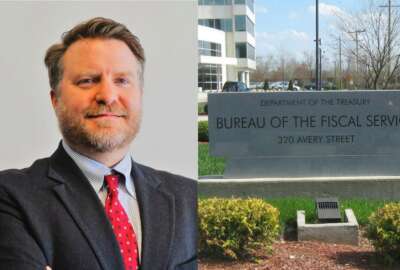
Treasury Dept. to overhaul CFO role with focus on data-driven decision-making
The President's Management Agenda addressed the need for agencies to overhaul their approach to customer experience, but the Treasury Department has drafted a p...
The President’s Management Agenda addressed the need for agencies to overhaul their approach to customer experience — making it easier for their customers to seek help online, over the phone or in-person — but the Treasury Department has drafted a plan to put those ideas into practice.
In a recent letter to agency chief financial officers, Bureau of the Fiscal Service Commissioner Tim Gribben pointed to the department’s 10-year vision for the future of financial management as the roadmap for how the agency intends to provide better service to the public.
Dave Lebryk, the Treasury Department’s fiscal assistant secretary, said that vision prioritizes delivering a “modern, seamless and secure experience” to the public — a tall order for public-facing agencies like the IRS, which processed more than 137 million tax returns last filing season, and the Social Security Administration, which disperses payments to more than 85 million beneficiaries.
“It’s not necessarily that our delivery is getting worse, it’s just not getting better — it’s not keeping up with what people are experiencing in other parts of their life,” Lebryk said July 24 in an interview at the Association of Government Accountants Professional Development Training conference in New Orleans.
But agencies have taken a different approach to customer experience than the private sector. Members of the public, for example, can’t take their business elsewhere if they’ve had a bad experience with the IRS.
“It’s really important that that experience be a positive one, because it’s so tied to trust in government. When someone has a positive experience with government, they’re nine times more likely to trust government than when they have a negative [experience],” he said.
While agencies have taken efforts to overhaul their websites or streamline their call center operations, Lebryk said Treasury is looking at the entire customer experience from beginning to end.
“We tend to think about pieces of the journey — our website, how’s it doing, how are our call centers doing, but not necessarily thinking about what was that experience [like] from the first interaction with the federal government to the final outcome of what you were trying to achieve,” Lebryk said.
While a handful of agencies have their own chief experience officers, Lebryk said Treasury’s vision looks to reshape the role of the chief financial officers into one that puts more of a focus on data-driven decision-making.
The transformation of that position means less time spent by the CFO on budget formulation and execution, or any number of “low-value, transaction-type” tasks described by Lebryk.
“What we talked about is how do we make the CFO more of a driver of taking data and compiling data and making it more useful for decision-makers. That really is at the core: How do you actually harness the data?” he said. “How do you have better standards around the data? And then how do you use that data to measure the outcomes of government?”
That shift toward data-driven decisionmaking also marks a shift away from agency CFO shops just seeking a clean audit opinion as the gold standard for financial management. Instead, the goal will be around-the-clock transparency into agency spending.
“I don’t want to diminish the importance of having good clean, audited financial statements for the government, and that’s a worthy thing, but … that doesn’t necessarily translate into decision-making and actually translate into useful information about how do you allocate those resources, and what programs are effective and which programs are not effective,” Lebryk said. “I see, as we’re going forward in the future, how do you make sure that the CFO is not spending his or her time on financial systems, but has systems available to him or her that actually produce good data and reports that can result in better decisions and better allocation of resources.”
Treasury’s Bureau of the Fiscal Service has taken a particular emphasis to this data-centric approach, and recently launched an online tracker called Your Guide to America’s Finances that collects real-time data on commonly asked questions about federal revenue and spending.
Lebryk said the government is still catching up with the private sector in terms of embracing RPA, but with so many use cases, he said agencies are “on the cusp of embracing” these automation tools, but remains in the early stages of “next step” emerging tools like machine learning, artificial intelligence and blockchain.
The benefits of automation also extend to rank-and-file employees. About 40,000 federal employees work on transaction processing as part of their jobs, but automating those tasks with robotic process automation could allow for faster, more efficient processing.”
“There’s a very strong business case to be made that if you can do a better job of automating and simplifying those transactions, you can achieve significant cost savings without reducing — actually in many cases in improving — speed and quality of the underlying activity for the agency,” Lebryk said.
Treasury will soon have the opportunity to streamline the role of the CFO across agencies. In April, the Trump administration selected Treasury to serve as the Quality Services Management Office (QSMO) for financial management.
In this role, Lebryk said Treasury will standardize financial transactions across the government, a worthwhile goal, considering that about 85% of core financial systems in the federal government runs about the same, but that remaining 15% of customization has resulted in more than 40 different financial systems, each configured in their own way.
“When you have more standardized centralized core financial systems, it requires you to do a better job of standardizing your data,” he said. “The QSMO for financial management is actually looking at the standards for many of the systems and looking at many of the accounting standards, making sure that you’re applying those standards of system standards and adhering to them, And actually how you go out there and obtains those kinds of services, whether it be software or hardware, but primarily software that those offerings are consistent with the federal government’s needs, when you have more centralized delivery of that sort of core financial management system, it’s going to result in better data and less time spent on actual systems, and more time actually having the ability to take that data and make use of it.
Copyright © 2024 Federal News Network. All rights reserved. This website is not intended for users located within the European Economic Area.
Jory Heckman is a reporter at Federal News Network covering U.S. Postal Service, IRS, big data and technology issues.
Follow @jheckmanWFED
Related Stories

Bureau of Fiscal Service improving security, user experience of its citizen services




